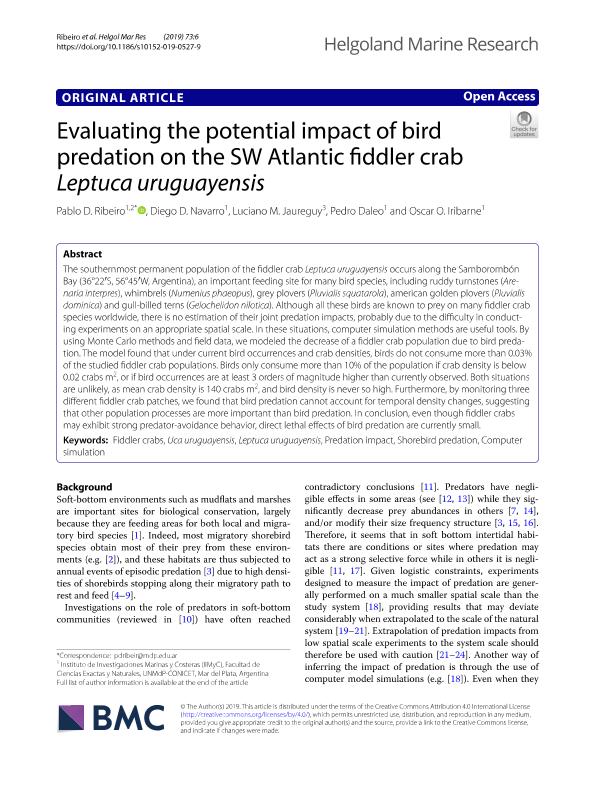Mostrar el registro sencillo del ítem
dc.contributor.author
Ribeiro, Pablo Damián

dc.contributor.author
Navarro, Diego

dc.contributor.author
Jaureguy, Luciano M.
dc.contributor.author
Daleo, Pedro

dc.contributor.author
Iribarne, Oscar Osvaldo

dc.date.available
2021-01-08T16:53:53Z
dc.date.issued
2019-09
dc.identifier.citation
Ribeiro, Pablo Damián; Navarro, Diego; Jaureguy, Luciano M.; Daleo, Pedro; Iribarne, Oscar Osvaldo; Evaluating the potential impact of bird predation on the SW Atlantic fiddler crab Leptuca uruguayensis; Springer; Helgoland Marine Research; 73; 1; 9-2019; 6-6
dc.identifier.issn
1438-387X
dc.identifier.uri
http://hdl.handle.net/11336/121946
dc.description.abstract
The southernmost permanent population of the fiddler crab Leptuca uruguayensis occurs along the Samborombón Bay (36°22′S, 56°45′W, Argentina), an important feeding site for many bird species, including ruddy turnstones (Arenaria interpres), whimbrels (Numenius phaeopus), grey plovers (Pluvialis squatarola), american golden plovers (Pluvialis dominica) and gull-billed terns (Gelochelidon nilotica). Although all these birds are known to prey on many fiddler crab species worldwide, there is no estimation of their joint predation impacts, probably due to the difficulty in conducting experiments on an appropriate spatial scale. In these situations, computer simulation methods are useful tools. By using Monte Carlo methods and field data, we modeled the decrease of a fiddler crab population due to bird predation. The model found that under current bird occurrences and crab densities, birds do not consume more than 0.03% of the studied fiddler crab populations. Birds only consume more than 10% of the population if crab density is below 0.02 crabs m2, or if bird occurrences are at least 3 orders of magnitude higher than currently observed. Both situations are unlikely, as mean crab density is 140 crabs m2, and bird density is never so high. Furthermore, by monitoring three different fiddler crab patches, we found that bird predation cannot account for temporal density changes, suggesting that other population processes are more important than bird predation. In conclusion, even though fiddler crabs may exhibit strong predator-Avoidance behavior, direct lethal effects of bird predation are currently small.
dc.format
application/pdf
dc.language.iso
eng
dc.publisher
Springer

dc.rights
info:eu-repo/semantics/openAccess
dc.rights.uri
https://creativecommons.org/licenses/by-nc-sa/2.5/ar/
dc.subject
FIDDLER CRABS
dc.subject
UCA URUGUAYENSIS
dc.subject
LEPTUCA URUGUAYENSIS
dc.subject
PREDTION IMPACT
dc.subject
SHOREBIRD PREDATION
dc.subject
COMPUTER SIMULATION
dc.subject.classification
Zoología, Ornitología, Entomología, Etología

dc.subject.classification
Ciencias Biológicas

dc.subject.classification
CIENCIAS NATURALES Y EXACTAS

dc.title
Evaluating the potential impact of bird predation on the SW Atlantic fiddler crab Leptuca uruguayensis
dc.type
info:eu-repo/semantics/article
dc.type
info:ar-repo/semantics/artículo
dc.type
info:eu-repo/semantics/publishedVersion
dc.date.updated
2020-11-26T17:50:03Z
dc.journal.volume
73
dc.journal.number
1
dc.journal.pagination
6-6
dc.journal.pais
Alemania

dc.description.fil
Fil: Ribeiro, Pablo Damián. Consejo Nacional de Investigaciones Científicas y Técnicas. Centro Científico Tecnológico Conicet - Mar del Plata. Instituto de Investigaciones Marinas y Costeras. Universidad Nacional de Mar del Plata. Facultad de Ciencias Exactas y Naturales. Instituto de Investigaciones Marinas y Costeras; Argentina
dc.description.fil
Fil: Navarro, Diego. Consejo Nacional de Investigaciones Científicas y Técnicas. Centro Científico Tecnológico Conicet - Mar del Plata. Instituto de Investigaciones Marinas y Costeras. Universidad Nacional de Mar del Plata. Facultad de Ciencias Exactas y Naturales. Instituto de Investigaciones Marinas y Costeras; Argentina
dc.description.fil
Fil: Jaureguy, Luciano M.. Universidad Nacional de Mar del Plata. Facultad de Ciencias Exactas y Naturales. Departamento de Biología; Argentina
dc.description.fil
Fil: Daleo, Pedro. Consejo Nacional de Investigaciones Científicas y Técnicas. Centro Científico Tecnológico Conicet - Mar del Plata. Instituto de Investigaciones Marinas y Costeras. Universidad Nacional de Mar del Plata. Facultad de Ciencias Exactas y Naturales. Instituto de Investigaciones Marinas y Costeras; Argentina
dc.description.fil
Fil: Iribarne, Oscar Osvaldo. Consejo Nacional de Investigaciones Científicas y Técnicas. Centro Científico Tecnológico Conicet - Mar del Plata. Instituto de Investigaciones Marinas y Costeras. Universidad Nacional de Mar del Plata. Facultad de Ciencias Exactas y Naturales. Instituto de Investigaciones Marinas y Costeras; Argentina
dc.journal.title
Helgoland Marine Research

dc.relation.alternativeid
info:eu-repo/semantics/altIdentifier/url/https://hmr.biomedcentral.com/articles/10.1186/s10152-019-0527-9
dc.relation.alternativeid
info:eu-repo/semantics/altIdentifier/doi/http://dx.doi.org/10.1186/s10152-019-0527-9
Archivos asociados
